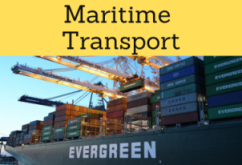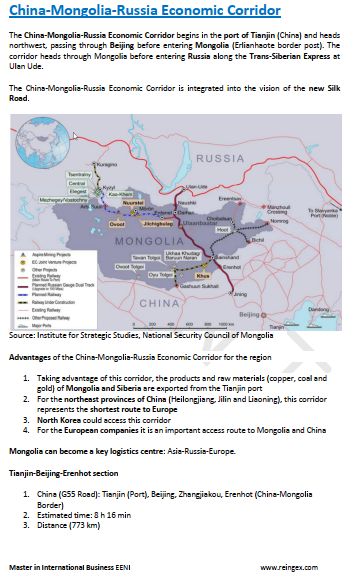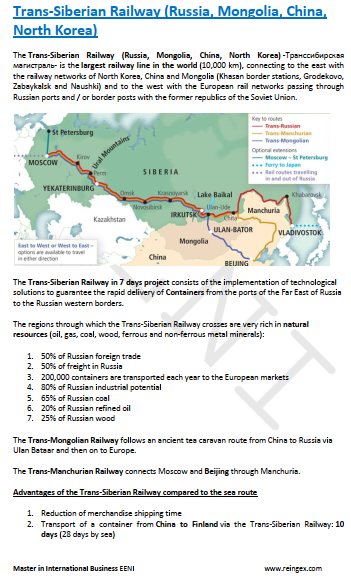China, Marine Transport, Logistics Corridors

Chinese Logistics Sector, Transport Corridors, Ports of China (Shanghai, Tianjin, Guangzhou, Ningbo)

- Introduction to the Marine Transport in China
- Largest ports of China
- Port of Shanghai
- Port of Shenzhen
- Port of Guangzhou
- Port of Qingdao
- Port of Dalian
- Port of Tianjin
- Ningbo Port
- Main Logistics Companies;
- COSCO
- China Shipping Container Lines
- SINOTRANS

- Almaty-Bishkek Corridor
- Trans-Siberian Railway (Russia, North Korea)
- Bangladesh-Myanmar Corridor
- China-Russia Corridor
- Nanning-Singapore Corridor
- China-Pakistan Corridor
- China-Central-West Asia Corridor
- Access to:


The Subject “Marine Transport and Corridors in China” belongs to the following Online Programs taught by EENI Global Business School:
Masters: International Business, Foreign Trade.
Course: Taoism, Confucianism & Business.


The Coastal ports of China enable international transport of coal, containers, imported iron ore, and grain; roll-on-roll-off operations between the mainland China and the islands; and deep-water access to the sea.
The freight volumes handled by some large ports surpass 100 million tones / year; the ports of Shanghai, Shenzhen, Qingdao, Tianjin, Guangzhou, Xiamen, Ningbo, and Dalian are among the top fifty container ports in the World.
Today; it comes to being three levels of container ports:
- Container main route ports, which include eight ports of Dalian, Tianjin, Qingdao, Shanghai, Ningbo, Xia'men, Shenzhen, and Guangzhou
- Feeder ports around those largest ports
- Minor local ports
China becomes the largest container Import-Export nation in the World.
The Port of Shanghai is situated in the middle of the 18,000 kilometers-long Chinese coastlines, where the Yangtze River, known as “the Golden Waterway,” flows into the sea. The Port of Shanghai is the leading port in the T-shaped waterway network composed by the Yangtze River and the coastline.
The Port of Shanghai is the largest exhaustive port of China and one of the Chinese largest gateways for foreign trade. The Port of Shanghai serves large hinterland the Yangtze River Delta and the entire Yangtze River valley. The annual import and export trade through Shanghai accounts for a 25% of the Chinese total trade.
The Shanghai International Port (Group) is the exclusive operator of all the public terminals in the Port of Shanghai
The Ningbo Port is well situated in the middle of the coastline of China, at the T-shaped joining point of the coastline of China and the Yangtze River. It is a famous deep-water port of mainland China. It enjoys sole natural conditions with convenient traffic reaching in all directions. Outwardly the port links East Asia and the whole round-the-Pacific region. The port has remained the second in cargo throughput and the fourth in container throughput in China (top eleventh in the World).
The Port of Shenzhen is one of the engaged (busiest) and fastest growing ports in Southern Mainland China. The Port of Shenzhen is situated in the Southern region of the Greater Pearl River Delta in Guangdong province. It is the economic hinterland for Hong Kong trade with the Mainland and one of the largest port of the international trade of China.
The Port of Guangzhou is the largest exhaustive hub port in South China. With the impulse from the fast growing economy in its hinterlands, Port of Guangzhou keeps a sustainable increase in the cargo volume. It is the third port in China to register annual traffic more than 400 million tones, after the Ports of Shanghai and Ningbo. Guangzhou has become a bridgehead for global logistics giants to make the inroads into the Chinese market and Hong Kong.
The Port of Qingdao is the largest port for inbound iron ore in the World, the largest port for inbound crude oil of China, and the second largest Chinese port of international trade. The Port of Qingdao boasts the highest productivity for container and iron ore handling in the World
The Port of Dalian is situated at the central point of Northwest Pacific, a gateway for this region to the Pacific and the rest of the World. With wide space and Deepwater, free of ice, the Port has superior natural conditions, the most convenient seaport for the transhipment of cargoes between Far East, South Asia, North America, and Europe.
The Port of Tianjin is the largest man-made port in China. The Port of Tianjin is the gate of Beijing and Tianjin, and an important trade port in northern China.
On a global basis, China's Rail transport volume is one of the largest in the World, having six% of the World's operating railways, and carrying 25% of the total railway workload in the World.


(c) EENI Global Business School (1995-2024)
We do not use cookies
Top of this page




 or
or 

